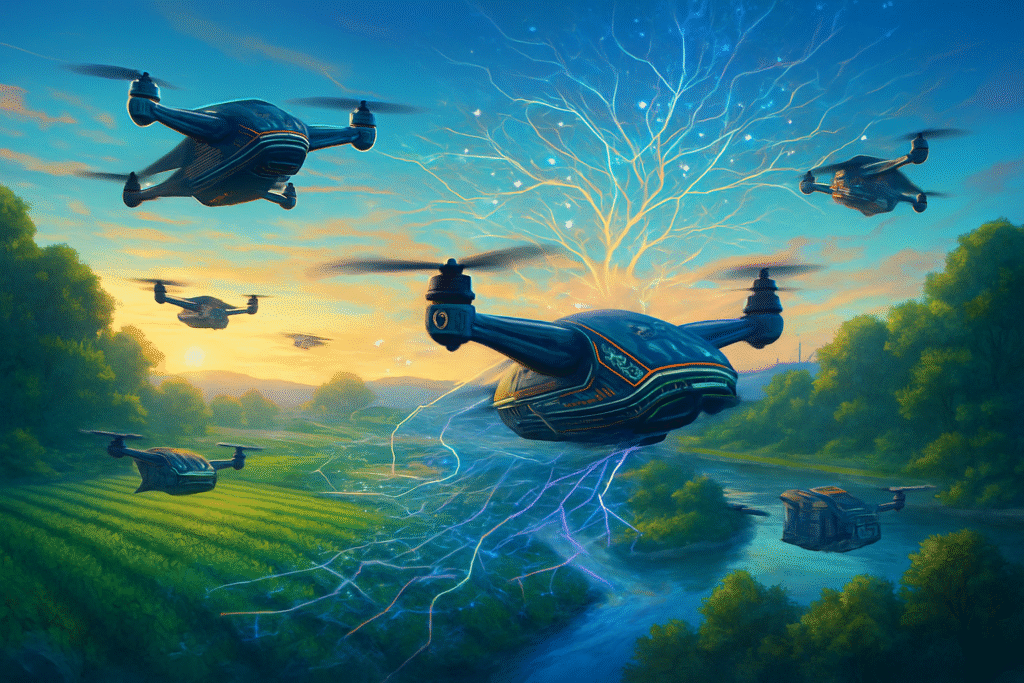
The global technology landscape is witnessing a profound shift as local startups, often deeply rooted in indigenous communities, emerge as formidable innovators in the fields of artificial intelligence and advanced drone technology. These trailblazing companies are not merely adopting existing tech; they are developing groundbreaking, indigenous solutions tailored to unique environmental, social, and economic challenges. From enhancing national security with autonomous aerial systems to empowering tribal nations with streamlined grant funding, these advancements signify a powerful convergence of traditional knowledge and cutting-edge innovation, promising a future of greater autonomy, sustainability, and economic prosperity.
These indigenous technological advancements are immediately significant, demonstrating a capability to solve localized problems with global implications. They represent a movement towards technological self-determination, where communities are building tools that directly serve their specific needs, often blending cultural values and traditional ecological knowledge with the latest in AI and robotics. This approach is not only fostering innovation but also creating new economic pathways and strengthening community resilience in an increasingly interconnected world.
A Deep Dive into Indigenous AI and Drone Breakthroughs
The technical prowess demonstrated by these local startups is truly remarkable, pushing the boundaries of what AI and drone technology can achieve. In India, Zuppa Geo Navigation Technologies Pvt Ltd has emerged as a leader in indigenous drone navigation. Their core innovation, the patented Disseminated Parallel Control Computing (DPCC) architecture developed in 2015, allows drones and autonomous systems to process sensory data in real time and make split-second decisions without constant cloud connectivity, mimicking human reflexes. This differs significantly from many existing drone systems that rely heavily on continuous GPS or cloud processing, making Zuppa's solutions highly resilient in GPS-denied or hostile environments, crucial for defense and critical infrastructure applications. Zuppa's collaboration with German startup Eighth Dimension to develop AI-based teaming algorithms for swarm drones further exemplifies their commitment to advanced autonomy.
Similarly, Aerpace Industries Limited in India, through its "aerShield" initiative, has introduced an indigenous AI-powered, modular drone ecosystem. At its heart is "aerOS," an AI-based autonomous drone control platform that provides real-time flight navigation, mission execution, obstacle avoidance, and precision targeting. This system powers advanced drones like the aerRecon ARM-5 and ARM-10 for border surveillance and the aerReaper AMMO-R7 for tactical strike missions. The integration of real-time AI for autonomous decision-making sets these systems apart, offering dynamic adaptability in complex operational environments with minimal human intervention, a clear departure from more human-piloted or pre-programmed drone systems.
Beyond defense, AI is empowering Indigenous communities in crucial administrative and environmental tasks. Syncurrent, a U.S. startup, has developed an AI-powered platform that navigates the complex landscape of grant funding for Tribal Nations. The platform intelligently scrapes federal, state, and philanthropic databases, identifying and aggregating grant opportunities specifically tailored to tribal governments' needs. This innovation drastically streamlines a historically arduous process, differing from generic grant search engines by its specialized focus and deep understanding of tribal funding requirements, thereby significantly improving access to essential resources for community development. In Australia, a collaboration between Microsoft (NASDAQ: MSFT), CSIRO, and Indigenous rangers in Kakadu National Park has led to an AI tool that automatically identifies invasive para grass from drone footage. This system merges Traditional Ecological Knowledge (TEK) with advanced machine learning, allowing rangers to detect the invasive species at various lifecycle stages without dangerous ground traverses, offering a more efficient and culturally sensitive approach to environmental management than manual surveys.
Reshaping the AI and Tech Industry Landscape
These indigenous technological advancements are poised to significantly reshape the competitive landscape for AI companies, tech giants, and startups alike. Local startups like Zuppa Geo Navigation Technologies Pvt Ltd and Aerpace Industries Limited stand to benefit immensely, positioning their respective nations as leaders in defense-grade drone navigation and autonomous systems. Their innovations create a strategic advantage by reducing reliance on foreign technology, bolstering national security, and opening up new markets for dual-use technologies that serve both civilian and military applications. The competitive implications for major AI labs and tech companies are substantial; these indigenous solutions demonstrate that innovation can thrive outside traditional tech hubs, challenging the notion of centralized technological development.
The potential disruption to existing products and services is evident, particularly in sectors like defense, agriculture, and environmental management. For instance, Grene Robotics' "Indrajaal" system, an Indian autonomous Wide Area Anti-Drone/Counter-Unmanned Aerial System (C-UAS), offers aerial security over vast areas, detecting and neutralizing various aerial threats. This comprehensive solution could disrupt conventional air defense strategies by providing a cost-effective, AI-powered alternative for protecting critical assets. Similarly, Marut Drones' agri-intelligence and agri-automation solutions for precision agriculture could challenge traditional farming methods and agricultural tech providers by offering highly localized and efficient drone-based solutions for crop monitoring and disease detection, contributing significantly to national food security and sustainable farming practices.
Market positioning and strategic advantages are also being redefined. Startups like Syncurrent and the Indigenomics Institute are carving out essential niches by addressing the specific economic and administrative needs of Indigenous communities. Syncurrent's platform empowers Tribal Nations by streamlining grant access, while the Indigenomics Institute's AI tool quantifies Indigenous economic activity, highlighting its true value and fostering greater economic opportunities. These specialized AI applications demonstrate a powerful market positioning built on cultural relevance and targeted problem-solving, offering solutions that traditional tech giants may overlook or fail to adequately address.
Broader Significance and Societal Impacts
The rise of indigenous AI and drone innovations fits seamlessly into the broader AI landscape, aligning with trends towards "AI for good," localized problem-solving, and the ethical integration of technology with cultural heritage. These developments underscore a critical shift from generic, one-size-fits-all technological solutions to highly contextualized and culturally appropriate applications. The impact is profound: enhanced environmental stewardship through precision monitoring and targeted intervention, economic empowerment for historically marginalized communities, and strengthened national security through advanced autonomous defense systems.
Potential concerns, however, also warrant consideration. As with any advanced technology, questions around data sovereignty, ethical AI development, and the potential for misuse must be carefully addressed. Ensuring that these AI tools are developed and deployed in a manner that respects privacy, cultural protocols, and community autonomy is paramount. The comparison to previous AI milestones highlights the unique aspect of these indigenous innovations: they are not just about pushing technological boundaries, but also about fostering self-determination and preserving traditional knowledge. While past breakthroughs often focused on general-purpose AI, these initiatives demonstrate the power of AI when applied to specific, often overlooked, societal challenges, setting a new precedent for how technology can serve diverse communities.
The use of drones by Indigenous communities in Australia and Brazil to track endangered species, monitor land health, manage controlled burns, and combat illegal deforestation exemplifies this synergy. Programs like Minyerra Borrinyu (Buzz Wing) and the Mimal-Warddeken Drone Uplift Program in Australia, and the Uru-Eu-Wau-Wau tribe's use of drones in the Brazilian Amazon, demonstrate how Traditional Ecological Knowledge (TEK) combined with drone technology leads to improved habitat management, reduced wildfires, and enhanced data sovereignty. These efforts are not just technological feats; they are vital contributions to global environmental conservation and community resilience.
The Horizon: Future Developments and Challenges
Looking ahead, the trajectory for indigenous AI and drone developments is one of continued growth and expanded application. In the near term, we can expect to see further integration of AI into drone autonomy, leading to more sophisticated swarm intelligence, enhanced real-time decision-making, and even greater resilience in challenging environments. The applications will diversify, moving beyond defense and agriculture into areas like infrastructure inspection, disaster response, and personalized healthcare delivery in remote regions. For AI-powered administrative tools, continued refinement in natural language processing and data analytics will allow for even more precise and proactive support for grant discovery, economic forecasting, and policy development within Indigenous communities.
Long-term developments are likely to include the creation of fully autonomous AI ecosystems that can operate with minimal human oversight, learning and adapting to dynamic conditions. We might see advanced drone networks capable of collaborative environmental monitoring across vast territories, or AI platforms that facilitate complex economic planning and resource management for entire regions. The potential applications are vast, from leveraging AI for preserving endangered indigenous languages and cultural heritage to developing smart infrastructure solutions tailored to unique geographical and cultural contexts.
However, several challenges need to be addressed for these innovations to reach their full potential. Securing consistent funding and investment, particularly for startups in underserved regions, remains a critical hurdle. Scaling these bespoke solutions to broader markets while maintaining their cultural specificity and ethical integrity will also require careful navigation. Furthermore, ensuring access to cutting-edge education and training for Indigenous youth in AI and robotics is essential to sustain this wave of innovation and prevent a new digital divide. Experts predict a future where these indigenous technological advancements not only solve local problems but also offer models for sustainable and equitable development that can be adapted globally, emphasizing the power of localized innovation.
A New Chapter in AI History
The indigenous technological advancements in AI-powered tools and advanced drones, spearheaded by local startups, mark a significant chapter in the ongoing history of artificial intelligence. The key takeaways are clear: innovation is global, deeply contextual, and thrives when technology is developed with a profound understanding of specific needs and cultural values. This movement underscores the immense potential of AI and robotics to not only drive economic growth but also to foster self-determination, environmental sustainability, and social equity.
The significance of these developments in AI history cannot be overstated. They represent a powerful counter-narrative to the often centralized and homogenous nature of technological progress, showcasing how diverse perspectives and traditional knowledge can enrich and expand the very definition of innovation. What we are witnessing is not just the creation of new tools, but the forging of new pathways for technological empowerment and the redefinition of who leads the charge in shaping our digital future.
In the coming weeks and months, it will be crucial to watch for continued investment in these local startups, the expansion of their pilot programs, and the emergence of new policy frameworks that support ethical AI development and data sovereignty for Indigenous communities. The world is learning that the most impactful innovations often arise from the places and people closest to the problems, demonstrating that the future of AI is intrinsically linked to its ability to serve all of humanity, in all its rich diversity.
This content is intended for informational purposes only and represents analysis of current AI developments.
TokenRing AI delivers enterprise-grade solutions for multi-agent AI workflow orchestration, AI-powered development tools, and seamless remote collaboration platforms.
For more information, visit https://www.tokenring.ai/.




